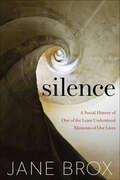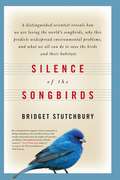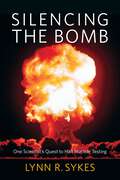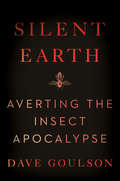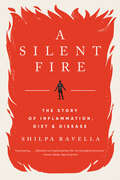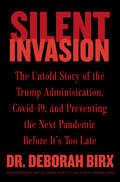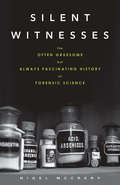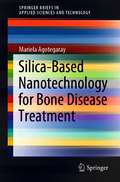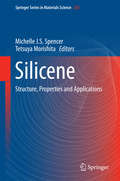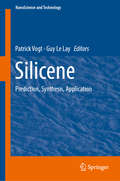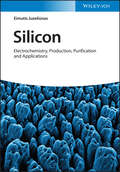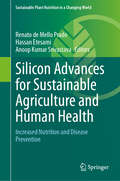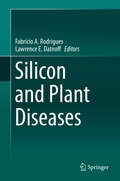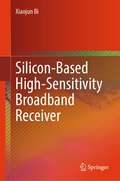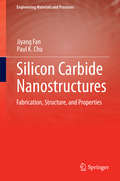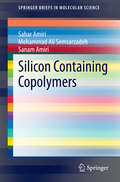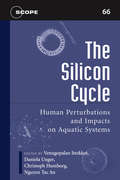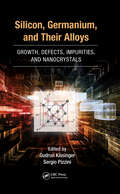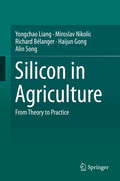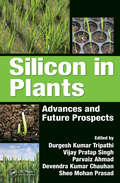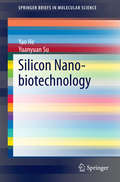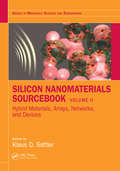- Table View
- List View
Silence: A Social History of One of the Least Understood Elements of Our Lives
by Jane BroxA compelling history of silence as a shaper of the human mind—in prisons, in places of contemplation, and in our own lives—from the author of Brilliant.Through her evocative intertwined histories of the penitentiary and the monastery, Jane Brox illuminates the many ways silence is far more complex than any absolute; how it has influenced ideas of the self, soul, and society. Brox traces its place as a transformative power in the monastic world from Medieval Europe to the very public life of twentieth century monk Thomas Merton, whose love for silence deepened even as he faced his obligation to speak out against war. This fascinating history of ideas also explores the influence the monastic cell had on one of society’s darkest experiments in silence: Eastern State Penitentiary. Conceived of by one of the Founding Fathers and built on the outskirts of Philadelphia, the penitentiary’s early promulgators imagined redemption in imposed isolation, but they badly misapprehended silence’s dangers.Finally, Brox’s rich exploration of silence’s complex and competing meanings leads us to imagine how we might navigate our own relationship with silence today, for the transformation it has always promised, in our own lives. “Brox writes beautifully . . . Silence for her is a force of nature, awe provoking, like lightning, capable of electrocuting us and of illuminating the night.” —The New York Times Book Review“Silence is an uncommon book on an increasingly uncommon phenomenon, a gift to be treasured in the din of daily life.” —Megan Marshall, Pulitzer Prize–winning author“A perceptive and subtle meditation about a ‘true reckoning with the self.’” —Kirkus Reviews
Silence of the Songbirds
by Bridget StutchburySince 1970 the population of songbirds in the United States and Canada has fallen by 30 percent. From their winter homes in the neotropical rainforests to their breeding grounds in northern Canada songbirds face a host of hazards caused by human-made changes to the environment. The author explores the impact of deforestation, habitat fragmentation, pesticides, city lights, and marauding cats on songbird survival. She outlines steps we can take to save the songbirds before it is too late.
Silencing the Bomb: One Scientist's Quest to Halt Nuclear Testing
by Lynn R. SykesIn December 2016, the Bulletin of Atomic Scientists moved their iconic “Doomsday Clock” thirty seconds forward to two and a half minutes to midnight, the latest it has been set since 1952, the year of the first United States hydrogen bomb test. But a group of scientists—geologists, engineers, and physicists—has been fighting to turn back the clock. Since the dawn of the Cold War, they have advocated a halt to nuclear testing, their work culminating in the Comprehensive Test Ban Treaty, which still awaits ratification from China, Iran, North Korea—and the United States. The backbone of the treaty is every nation’s ability to independently monitor the nuclear activity of the others. The noted seismologist Lynn R. Sykes, one of the central figures in the development of the science and technology used in monitoring, has dedicated his career to halting nuclear testing. In Silencing the Bomb, he tells the inside story behind scientists’ quest for disarmament.Called upon time and again to testify before Congress and to inform the public, Sykes and his colleagues were, for much of the Cold War, among the only people on earth able to say with certainty when and where a bomb was tested and how large it was. Methods of measuring earthquakes, researchers realized, could also detect underground nuclear explosions. When politicians on both sides of the Iron Curtain attempted to sidestep disarmament or test ban treaties, Sykes was able to deploy the nascent science of plate tectonics to reveal the truth. Seismologists’ discoveries helped bring about treaties limiting nuclear testing, but it was their activism that played a key role in the effort for peace. Full of intrigue, international politics, and hard science used for the global good, Silencing the Bomb is a timely and necessary chronicle of one scientist’s efforts to keep the clock from striking midnight.
Silent Earth: Averting the Insect Apocalypse
by Dave Goulson“A terrific book…A thoughtful explanation of how the dramatic decline of insect species and numbers poses a dire threat to all life on earth.” (Booklist, Starred Review)In the tradition of Rachel Carson’s groundbreaking environmental classic Silent Spring, an award-winning entomologist and conservationist explains the importance of insects to our survival, and offers a clarion call to avoid a looming ecological disaster of our own making.Drawing on thirty years of research, Goulson has written an accessible, fascinating, and important book that examines the evidence of an alarming drop in insect numbers around the world. “If we lose the insects, then everything is going to collapse,” he warned in a recent interview in the New York Times—beginning with humans’ food supply. The main cause of this decrease in insect populations is the indiscriminate use of chemical pesticides. Hence, Silent Earth’s nod to Rachel Carson’s classic Silent Spring which, when published in 1962, led to the global banning of DDT. This was a huge victory for science and ecological health at the time.Yet before long, new pesticides just as lethal as DDT were introduced, and today, humanity finds itself on the brink of a new crisis. What will happen when the bugs are all gone? Goulson explores the intrinsic connection between climate change, nature, wildlife, and the shrinking biodiversity and analyzes the harmful impact for the earth and its inhabitants. Meanwhile we have all read stories about hive collapse syndrome affecting honeybee colonies and the tragic decline of monarch butterflies in North America, and more. But it is not too late to arrest this decline, and Silent Earth should be the clarion call. Smart, eye-opening, and essential, Silent Earth is a forceful call to action to save our world, and ultimately, ourselves.Silent Earth includes approximately 20 black-and-white illustrations and charts and graphs.
A Silent Fire: The Story Of Inflammation, Diet, And Disease
by Shilpa Ravella“Fascinating.…[Ravella’s writing] breathes life into biological functions.” —Grace Wade, New Scientist A riveting investigation of inflammation—the hidden force at the heart of modern disease—and how we can prevent, treat, or even reverse it. Inflammation is the body’s ancestral response to its greatest threats, the first line of defense it deploys against injury and foreign pathogens. But as the threats we face have evolved, new science is uncovering how inflammation may also turn against us, simmering underneath the surface of leading killers from heart disease and cancer to depression, aging, and mysterious autoimmune conditions. In A Silent Fire, gastroenterologist Shilpa Ravella investigates hidden inflammation’s emerging role as a common root of modern disease—and how we can control it. We meet the visionary nineteenth-century pathologist who laid the foundation for our modern understanding of inflammation, the eccentric Russian zoologist who discovered one of the cells central to our immune system, and the dedicated researchers advancing the frontiers of medical and nutritional science today. With fascinating case studies, Ravella reveals how we can reform our relationships with food and our microbiomes to benefit our own health and the planet’s. Synthesizing medical history, cutting-edge research, and innovative clinical practice, Ravella unveils inflammation as one potential basis for a unifying theory of disease. A paradigm-shifting understanding of one of the most mysterious, buzzed-about topics in medicine and nutrition, A Silent Fire shows us how to live not only long but well.
Silent Invasion: The Untold Story of the Trump Administration, Covid-19, and Preventing the Next Pandemic Before It's Too Late
by Deborah BirxThe definitive, inside account of the Trump Administration’s response to the Covid-19 pandemic from White House Coronavirus Response Coordinator and Coronavirus Task Force member, Dr. Deborah Birx.In late February 2020, Dr. Deborah Birx—a lifelong federal health official who had worked at the CDC, the State Department, and the US Army across multiple presidential administrations—was asked to join the Trump White House Coronavirus Task Force and assist the already faltering federal response to the Covid-19 pandemic. For weeks, she’d been raising the alarm behind the scenes about what she saw happening in public—from the apparent lack of urgency at the White House to the routine downplaying of the risks to Americans. Once in the White House, she was tasked with helping fix the broken federal approach and making President Trump see the danger this virus posed to all of us.Silent Invasion is the story of what she witnessed and lived for the next year—an eye-opening, inside account, detailed here for the first time, of the Trump Administration’s response to the greatest public health crisis in modern times. Regarded with suspicion in the West Wing from day one, Dr. Birx goes beyond the media speculation and political maneuvering to show what she was really up against in the Trump White House. Digging into the hard-fought victories, the costly mistakes, and the human drama surrounding the administration’s efforts, she examines the forces that crippled efforts to control the virus and explores why these blunders continue to haunt us today.And yet amid the agonizing missteps were bright spots that point the way forward—the fastest vaccine creation in history, governors that put their citizens’ health first, and Tribal Nations that demonstrated the powerful role of community in curbing spread, despite their criminally underfunded healthcare systems. Collectively these successes reveal the valiant work of many who were committed to saving lives, as well as highlighting the dire need to reform our public health institutions, so they are nimble and resilient enough to confront the next pandemic.With the pandemic now moving into its third year confounding two presidential administrations, Dr. Birx presents a story at once urgent and frustratingly unfinished, as Covid-19 continues to put thousands of American lives at risk. The end result is the most comprehensive and extensive accounting to date of the Trump Administration’s struggle to control the biggest health crisis in generations—a revelatory look at how we can learn from our mistakes and prevent this from happening again.
Silent Sparks: The Wondrous World of Fireflies
by Sara LewisFor centuries, the beauty of fireflies has evoked wonder and delight. Yet for most of us, fireflies remain shrouded in mystery: How do fireflies make their light? What are they saying with their flashing? And what do fireflies look for in a mate? In Silent Sparks, noted biologist and firefly expert Sara Lewis dives into the fascinating world of fireflies and reveals the most up-to-date discoveries about these beloved insects. From the meadows of New England and the hills of the Great Smoky Mountains, to the rivers of Japan and mangrove forests of Malaysia, this beautifully illustrated and accessible book uncovers the remarkable, dramatic stories of birth, courtship, romance, sex, deceit, poison, and death among fireflies. The nearly two thousand species of fireflies worldwide have evolved in different ways--and while most mate through the aerial language of blinking lights, not all do. Lewis introduces us to fireflies that don't light up at all, relying on wind-borne perfumes to find mates, and we encounter glow-worm fireflies, whose plump, wingless females never fly. We go behind the scenes to meet inquisitive scientists who have dedicated their lives to understanding fireflies, and we learn about various modern threats including light pollution and habitat destruction. In the last section of the book, Lewis provides a field guide for North American fireflies, enabling us to identify them in our own backyards and neighborhoods. This concise, handy guide includes distinguishing features, habits, and range maps for the most commonly encountered fireflies, as well as a gear list. A passionate exploration of one of the world's most charismatic and admired insects, Silent Sparks will inspire us to reconnect with the natural world.
Silent Witnesses: The Often Gruesome but Always Fascinating History of Forensic Science
by Nigel MccreryCrime novelist and former police officer Nigel McCrery provides an account of all the major areas of forensic science from around the world over the past two centuries. The book weaves dramatic narrative and scientific principles together in a way that allows readers to figure out crimes along with the experts. Readers are introduced to such fascinating figures as Dr. Edmond Locard, the "French Sherlock Holmes"; Edward Heinrich, "Wizard of Berkeley," who is credited with having solved more than 2,000 crimes; and Alphonse Bertillon, the French scientist whose guiding principle, "no two individuals share the same characteristics," became the core of criminal identification. Landmark crime investigations examined in depth include a notorious murder involving blood evidence and defended by F. Lee Bailey, the seminal 1936 murder that demonstrated the usefulness of the microscope in examining trace evidence, the 1849 murder of a wealthy Boston businessman that demonstrated how difficult it is to successfully dispose of a corpse, and many others.
Silica-Based Nanotechnology for Bone Disease Treatment (SpringerBriefs in Applied Sciences and Technology)
by Mariela AgotegarayThis book addresses conventional treatments of bone diseases. It proposes nanotechnological tools based on the use of silica as a bioactive material for bone. The book links the physiological and anatomical aspects of the bone with the ancestral importance of the bone system. It describes associated pathologies and conventional treatments, emphasizing their shortcomings. The book gives future perspectives and applicable tools to the development of new nanomaterials.
Silicene
by Michelle J.S. Spencer Tetsuya MorishitaThis book reviews the current state-of-the art of single layer silicene up to thicker silicon nanosheets, and their structure, properties and potential applications. Silicene is a newly discovered material that is one atomic layer think. It is a two-dimensional (2D) nanomaterial that is classified as a nanosheet, which has large lateral dimensions up to micrometres, but thicknesses of only nanometres or less. Silicon nanosheets are currently a very 'hot' area of research. The unique properties and morphology of such materials make them ideal for a variety of applications, including electronic devices, batteries and sensors. 2D nanosheets of silicon can be considered as analogues of graphene. As silicon is already the major component of electronic devices, the significance of nanosheets composed of silicon is that they can be more easily integrated into existing electronic devices. Furthermore, if 2D nanostructured Si can be implemented into such devices, then their size could be reduced into the nano-regime, providing unique properties different from bulk Si that is currently employed. The book is written for researchers and graduate students.
Silicene: Prediction, Synthesis, Application (NanoScience and Technology #930)
by Patrick Vogt Guy Le LayThis book discusses the processing and properties of silicene, including the historical and theoretical background of silicene, theoretical predictions, the synthesis and experimental properties of silicene and the potential applications and further developments. It also presents other similar monolayer materials, like germanene and phosphorene. Silicene, a new silicon allotrope with a graphene-like, honeycomb structure, has recently attracted considerable interest, because its topology affords it the same remarkable electronic properties as those of graphene. Additionally, silicene may have the potential advantage of being easily integrated in current Si-based nano/micro-electronics, offering novel technological applications.Silicene was theoretically conjectured a few years ago as a stand-alone material. However, it does not exist in nature and had to be synthesized on a substrate. It has since been successfully synthesized and multi-layer silicene structures are already being discussed. Within just a few years, silicene is now on the brink of technological applications in electronic devices.
Silicon: Electrochemistry, Production, Purification and Applications
by Eimutis JuzeliunasSilicon The expert reference on sustainable and energy-efficient production of photovoltaic-grade silicon materials Electrochemical methods, in particular molten-salt approaches, are a cost-effective, energy-efficient, and highly sustainable approach for producing solar-grade silicon. Surface micro- and nanostructuring methods for effective light harvesting, silicon electrorefining in molten salts, electrodeposition of photoresponsive films, and other related processes are likely to replace conventional carbothermic production methods. Silicon: Electrochemistry, Production, Purification and Applications presents an up-to-date summary of recent experimental and technological developments in the field, highlighting sustainable and energy-efficient processes for high-grade silicon production for a variety of photovoltaic and energy applications. Presented in a logical and concise format, this authoritative volume details the fundamental properties and technical processes of metal-grade silicon production and describes the various electrochemical methods for high-grade silicon production. Topics include silicon surface modification, chemical-physical structuring, porous and black silicon, electrochemical Si surface structuring and anodizing in molten salts, and more. Reviews the sustainable and energy-efficient production and purification of photovoltaic-grade silicon materials Summarizes recent progress in sustainable processes for high-grade silicon production Describes electrochemical methods for silicon production such as electrolysis, electrodeposition, and electrorefining Concludes with a discussion of future challenges and opportunities Written by a leading researcher in the field, Silicon: Electrochemistry, Production, Purification and Applications is a valuable resource for chemists and material scientists in academia and industry, particularly those working in sustainable energy development, photovoltaics, light harvesting efficiency, solar-to-chemical conversion, and production of solar-grade silicon, batteries, photoelectrodes, or silicon-based semiconductors.
Silicon Advances for Sustainable Agriculture and Human Health: Increased Nutrition and Disease Prevention (Sustainable Plant Nutrition in a Changing World)
by Renato de Mello Prado Hassan Etesami Anoop Kumar SrivastavaThis book addresses the most innovative topics on silicon to ensure sustainability in agriculture, including advances in nanotechnology and the impact on human health. It provides innovative information on the mineral nutrition of plants with a focus on the beneficial element silicon that has attracted the attention and interest of researchers. This is happening because silicon is the only element in plant nutrition that is capable of mitigating the greatest number of stressful events during plant cultivation. Faced with climate change associated with disease pressure due to the use of transgenic cultivars that decreases genetic variability and increases the occurrence of stress in crops. Associated with this, there is a need to reduce the use of chemical pesticides in crops to favor agro-environmental sustainability and thus increases the need for the use of silicon in agriculture. This is important because the main goal of plant mineral nutrition is to meet the demand of the plant and consequently of man and his nutritional requirements, but there is a lack of work to integrate the benefits of Si in plants and consequently its reflections on human health. The information in this work will drive further research to expand knowledge and the benefits of Si in sustainable agriculture and human health, and therefore, the target audience would be researchers, professors, students from universities and research institutes, as well as company technicians.
Silicon and Plant Diseases
by Fabrício A. Rodrigues Lawrence E. DatnoffSilicon, considered to be the second most abundant mineral element in soil, plays an important role in the mineral nutrition of plants. A wide variety of monocot and dicot species have benefited from silicon nutrition, whether direct or indirect, when they are exposed to different types of abiotic and or biotic stresses. Besides the many agronomic and horticultural benefits gained by maintaining adequate levels of this element in the soil and also in the plant tissue, the most notable effect of silicon is the reduction in the intensities of a number of plant diseases caused by biotrophic, hemibiotrophic and necrotrophic plant pathogens in many crops of great economic importance. The aim of this book is to summarize our current understanding of the effects of silicon on plant diseases. The chapters address the dynamics of silicon in soils and plants; the history of silicon in the control of plant diseases; the use of silicon to control soil-borne, seed-borne and foliar diseases in monocots and dicots; the mechanisms involved in the host resistance against infection by plant pathogens mediated by silicon as well as the current knowledge at the omics level, and finally, highlights and prospects for using silicon in the future.
Silicon-Based High-Sensitivity Broadband Receiver
by Xiaojun BiThis book presents various design theories and methodologies for silicon-based high-sensitivity broadband receivers, including millimeter-wave radiometer chips and photoelectric receivers, which are core elements in imaging systems, data centers, and telecommunication infrastructures. As a key module in application systems, the high-sensitivity broadband receiver, not only attracts the attention of engineers and researchers in the radio-frequency and optoelectronic fields, but also garners significant interest from other disciplines, including optics, communications, and security. The book introduces various silicon-based critical design technologies aim to overcome the limitations inherent in silicon devices, distinctly enhancing sensitivity with a broad bandwidth. These innovative design methodologies, initially proposed and subsequently validated through meticulous measurements, represent a pioneering contribution. The book provides readers with detailed insights into design intricacies and considerations. Its audience includes undergraduate and graduate students with a specific interest in RF/optoelectronic receiver technology, along with researchers and engineers engaged in the study of imaging systems, data centers, or other communication applications.
Silicon Carbide Nanostructures
by Jiyang Fan Paul K. ChuThis book brings together the most up-to-date information on the fabrication techniques, properties, and potential applications of low dimensional silicon carbide (SiC) nanostructures such as nanocrystallites, nanowires, nanotubes, and nanostructured films. It also summarizes the tremendous achievements acquired during the past three decades involving structural, electronic, and optical properties of bulk silicon carbide crystals. SiC nanostructures exhibit a range of fascinating and industrially important properties, such as diverse polytypes, stability of interband and defect-related green to blue luminescence, inertness to chemical surroundings, and good biocompatibility. These properties have generated an increasing interest in the materials, which have great potential in a variety of applications across the fields of nanoelectronics, optoelectronics, electron field emission, sensing, quantum information, energy conversion and storage, biomedical engineering, and medicine. SiC is also a most promising substitute for silicon in high power, high temperature, and high frequency microelectronic devices. Recent breakthrough pertaining to the synthesis of ultra-high quality SiC single-crystals will bring the materials closer to real applications. Silicon Carbide Nanostructures: Fabrication, Structure, and Properties provides a unique reference book for researchers and graduate students in this emerging field. It is intended for materials scientists, physicists, chemists, and engineers in microelectronics, optoelectronics, and biomedical engineering.
Silicon Containing Copolymers
by Sahar Amiri Mohammad Ali Semsarzadeh Sanam AmiriSilicones have unique properties including thermal oxidative stability, low temperature flow, high compressibility, low surface tension, hydrophobicity and electric properties. These special properties have encouraged the exploration of alternative synthetic routes of well defined controlled microstructures of silicone copolymers, the subject of this Springer Brief. The authors explore the synthesis and characterization of notable block copolymers. Recent advances in controlled radical polymerization techniques leading to the facile synthesis of well-defined silicon based thermo reversible block copolymers are described along with atom transfer radical polymerization (ATRP), a technique utilized to develop well-defined functional thermo reversible block copolymers. The brief also focuses on Polyrotaxanes and their great potential as stimulus-responsive materials which produce poly (dimethyl siloxane) (PDMS) based thermo reversible block copolymers.
The Silicon Cycle: Human Perturbations and Impacts on Aquatic Systems (SCOPE Series #66)
by Daniela Unger Nguyen Tac An Venugopalan Ittekkot Christoph HumborgSilicon is among the most abundant elements on earth. It plays a key but largely unappreciated role in many biogeochemical processes, including those that regulate climate and undergird marine food webs. The Silicon Cycle is the first book in more than 20 years to present a comprehensive overview of the silicon cycle and issues associated with it. The book summarizes the major outcomes of the project Land-Ocean Interactions: Silica Cycle, initiated by the Scientific Community on Problems of the Environment (SCOPE) of the International Council of Scientific Unions (ICSU). It tracks the pathway of silicon from land to sea and discusses its biotic and abiotic modifications in transit as well as its cycling in the coastal seas. Natural geological processes in combination with atmospheric and hydrological processes are discussed, as well as human perturbations of the natural controls of the silicon cycle.
Silicon Earth: Introduction to Microelectronics and Nanotechnology, Second Edition
by John D. CresslerWe are in the center of the most life-changing technological revolution the Earth has ever known. In little more than 65 years, an eye-blink in human history, a single technological invention has launched the proverbial thousand ships, producing the most sweeping and pervasive set of changes ever to wash over humankind; changes that are reshaping the very core of human existence, on a global scale, at a relentlessly accelerating pace. And we are just at the very beginning. Silicon Earth: Introduction to Microelectronics and Nanotechnology introduces readers with little or no technical background to the marvels of microelectronics and nanotechnology, using straightforward language, an intuitive approach, minimal math, and lots of pictures. The general scientific and engineering underpinnings of microelectronics and nanotechnology are described, as well as how this new technological revolution is transforming a broad array of interdisciplinary fields, and civilization as a whole. Special "widget deconstruction" chapters address the inner workings of ubiquitous micro/nano-enabled pieces of technology, such as smartphones, flash drives, and digital cameras. Completely updated and upgraded to full color, the Second Edition: Includes new material on the design of electronic systems, the future of electronics, and the societal impact of micro/nanotechnology Provides new widget deconstructions of cutting-edge tech gadgets like the GPS-enabled smartwatch Adds end-of-chapter study questions and hundreds of new color photos Silicon Earth: Introduction to Microelectronics and Nanotechnology, Second Edition is a pick-up-and-read-cover-to-cover book for those curious about the micro/nanoworld, as well as a classroom-tested, student-and-professor-approved text ideal for an undergraduate-level university course. Lecture slides, homework examples, a deconstruction project, and discussion threads are available via an author-maintained website.
Silicon, Germanium, and Their Alloys: Growth, Defects, Impurities, and Nanocrystals
by Gudrun Kissinger Sergio PizziniDespite the vast knowledge accumulated on silicon, germanium, and their alloys, these materials still demand research, eminently in view of the improvement of knowledge on silicon-germanium alloys and the potentialities of silicon as a substrate for high-efficiency solar cells and for compound semiconductors and the ongoing development of nanodevic
Silicon in Agriculture
by Yongchao Liang Miroslav Nikolic Richard Bélanger Haijun Gong Alin SongThis book mainly presents the current state of knowledge on the use of of Silicon (Si) in agriculture, including plants, soils and fertilizers. At the same time, it discusses the future interdisciplinary research that will be needed to further our knowledge and potential applications of Si in agriculture and in the environmental sciences in general. As the second most abundant element both on the surface of the Earth's crust and in soils, Si is an agronomically essential or quasi-essential element for improving the yield and quality of crops. Addressing the use of Si in agriculture in both theory and practice, the book is primarily intended for graduate students and researchers in various fields of the agricultural, biological, and environmental sciences, as well as for agronomic and fertilizer industry experts and advisors. Dr. Yongchao Liang is a full professor at the College of Environmental and Resource Sciences of the Zhejiang University, Hangzhou, China. Dr. Miroslav Nikolic is a research professor at the Institute for Multidisciplinary Research of the University of Belgrade, Serbia. Dr. Richard Bélanger is a full professor at the Department of Plant Pathology of the Laval University, Canada and holder of a Canada Research Chair in plant protection. Dr. Haijun Gong is a full professor at College of Horticulture, Northwest A&F University, China. Dr. Alin Song is an associate professor at Institute of Agricultural Resources and Regional Planning, Chinese Academy of Agricultural Sciences, Beijing, China.
Silicon in Plants: Advances and Future Prospects
by Sheo Prasad Vijay Singh Durgesh Tripathi Devendra Chauhan Parvaiz AhmadIn the present era, rapid industrialization and urbanization has resulted in unwanted physiological, chemical, and biological changes in the environment that have harmful effects on crop quality and productivity. This situation is further worsened by the growing demand for food due to an ever increasing population. This forces plant scientists and agronomists to look forward for alternative strategies to enhance crop production and produce safer, healthier foods. Biotic and abiotic stresses are major constraints to crop productivity and have become an important challenge to agricultural scientists and agronomists due to the fact that both stress factors considerably reduce agriculture production worldwide per year. Silicon has various effects on plant growth and development, as well as crop yields. It increases photosynthetic activity, creates better disease resistance, reduces heavy metal toxicity, improves nutrient imbalance, and enhances drought tolerance. Silicon in Plants: Advances and Future Prospects presents the beneficial effects of silicon in improving productivity in plants and enhancing the capacity of plants to resist stresses from environmental factors. It compiles recent advances made worldwide in different leading laboratories concerning the role of silicon in plant biology in order to make these outcomes easily accessible to academicians, researchers, industrialists, and students. Nineteen chapters summarize information regarding the role of silicon in plants, their growth and development, physiological and molecular responses, and responses against the various abiotic stresses.
Silicon Nano-biotechnology
by Yao He Yuanyuan SuThis book reviews the latest advances in the development of silicon nano-biotechnology for biological and biomedical applications, which include biosensing, bioimaging, and cancer therapy. In this book, newly developed silicon nano-biotechnology and its biomedical applications are systematically introduced. For instance, fluorescent silicon nanoparticles, serving as novel high-performance biological nanoprobes, are superbly suited to real-time and long-term bioimaging. Silicon nanowire-based sensing platform is especially capable of sensitive, specific, and multiplexed detection of various biological species. Silicon-based nanocarriers with ultra-high drug-loading capacity are highly efficacious for in vitro and in vivo cancer therapies. This book is intended for readers who are interested in the design of functional silicon nanostructures and their biological and biomedical applications. It uses silicon nanoparticles and silicon nanowires as models and discusses topics ranging from their synthesis to their biological applications, the goal being to highlight these exciting achievements as starting points in the field of silicon nano-biotechnology. Yao He is a Professor at Institute of Functional Nano&Soft Materials (FUNSOM), Soochow University, China. Yuanyuan Su is an Associate Professor at Institute of Functional Nano&Soft Materials (FUNSOM), Soochow University, China.
Silicon Nanomaterials Sourcebook: Low-Dimensional Structures, Quantum Dots, and Nanowires, Volume One (Series in Materials Science and Engineering)
by Klaus D. SattlerThis comprehensive tutorial guide to silicon nanomaterials spans from fundamental properties, growth mechanisms, and processing of nanosilicon to electronic device, energy conversion and storage, biomedical, and environmental applications. It also presents core knowledge with basic mathematical equations, tables, and graphs in order to provide the reader with the tools necessary to understand the latest technology developments. From low-dimensional structures, quantum dots, and nanowires to hybrid materials, arrays, networks, and biomedical applications, this Sourcebook is a complete resource for anyone working with this materials: Covers fundamental concepts, properties, methods, and practical applications. Focuses on one important type of silicon nanomaterial in every chapter. Discusses formation, properties, and applications for each material. Written in a tutorial style with basic equations and fundamentals included in an extended introduction. Highlights materials that show exceptional properties as well as strong prospects for future applications. Klaus D. Sattler is professor physics at the University of Hawaii, Honolulu, having earned his PhD at the Swiss Federal Institute of Technology (ETH) in Zurich. He was honored with the Walter Schottky Prize from the German Physical Society, and is the editor of the sister work also published by Taylor & Francis, Carbon Nanomaterials Sourcebook, as well as the acclaimed multi-volume Handbook of Nanophysics.
Silicon Nanomaterials Sourcebook: Hybrid Materials, Arrays, Networks, and Devices, Volume Two (Series in Materials Science and Engineering)
by Klaus D. SattlerThis comprehensive tutorial guide to silicon nanomaterials spans from fundamental properties, growth mechanisms, and processing of nanosilicon to electronic device, energy conversion and storage, biomedical, and environmental applications. It also presents core knowledge with basic mathematical equations, tables, and graphs in order to provide the reader with the tools necessary to understand the latest technology developments. From low-dimensional structures, quantum dots, and nanowires to hybrid materials, arrays, networks, and biomedical applications, this Sourcebook is a complete resource for anyone working with this materials: Covers fundamental concepts, properties, methods, and practical applications. Focuses on one important type of silicon nanomaterial in every chapter. Discusses formation, properties, and applications for each material. Written in a tutorial style with basic equations and fundamentals included in an extended introduction. Highlights materials that show exceptional properties as well as strong prospects for future applications. Klaus D. Sattler is professor physics at the University of Hawaii, Honolulu, having earned his PhD at the Swiss Federal Institute of Technology (ETH) in Zurich. He was honored with the Walter Schottky Prize from the German Physical Society, and is the editor of the sister work also published by Taylor & Francis, Carbon Nanomaterials Sourcebook, as well as the acclaimed multi-volume Handbook of Nanophysics.
